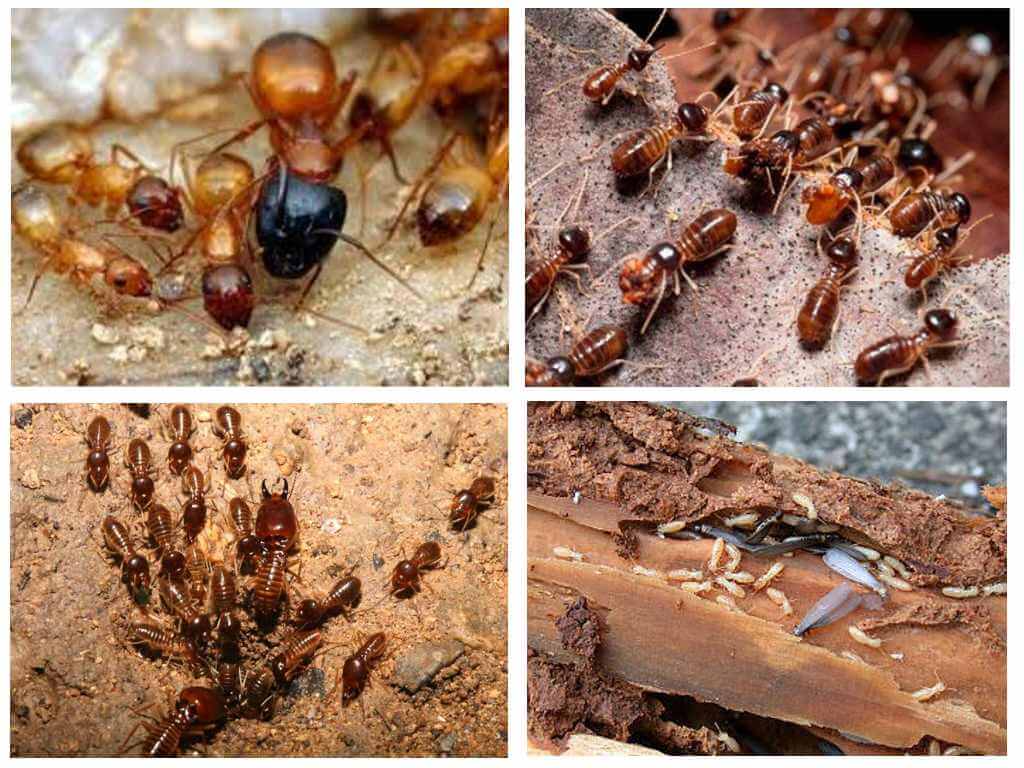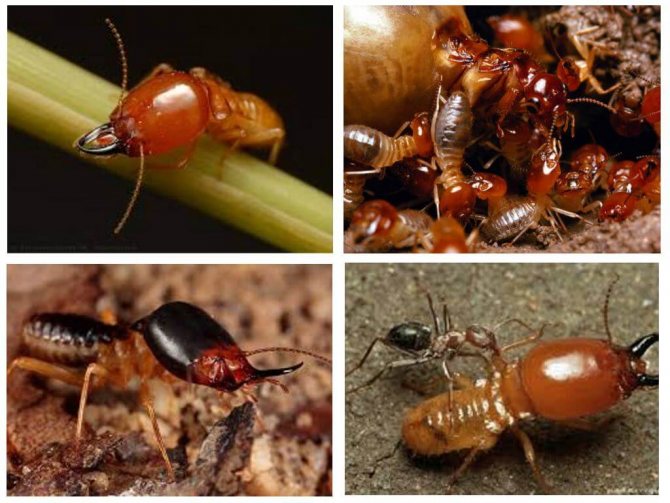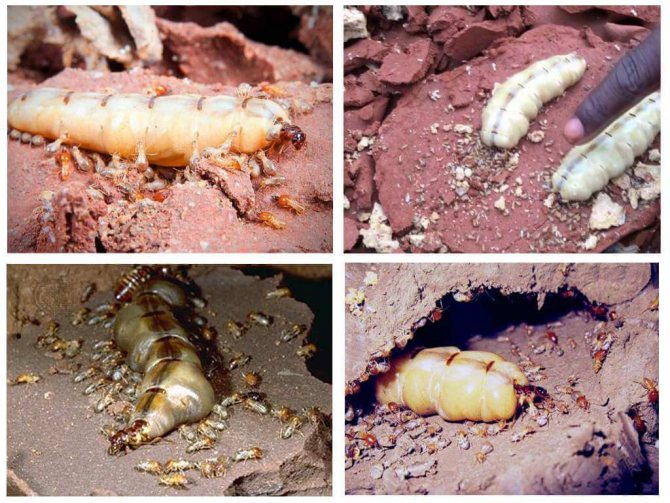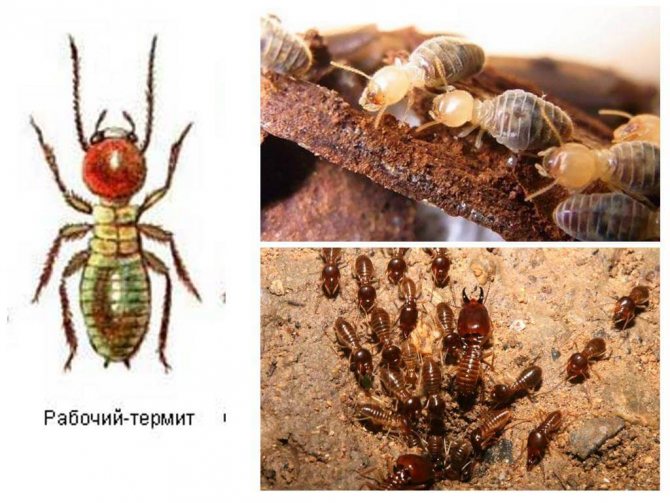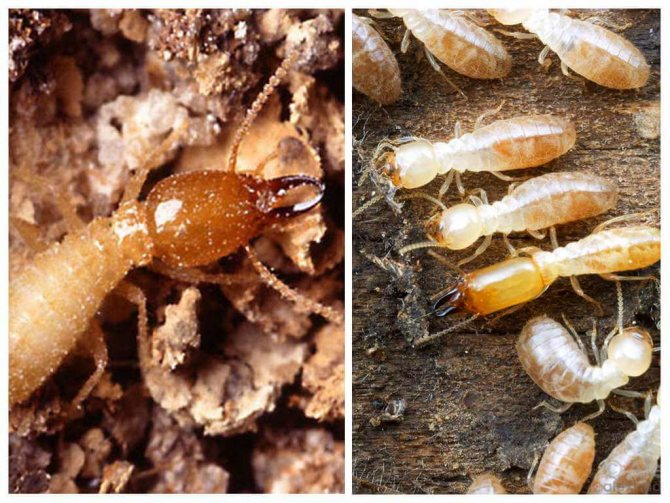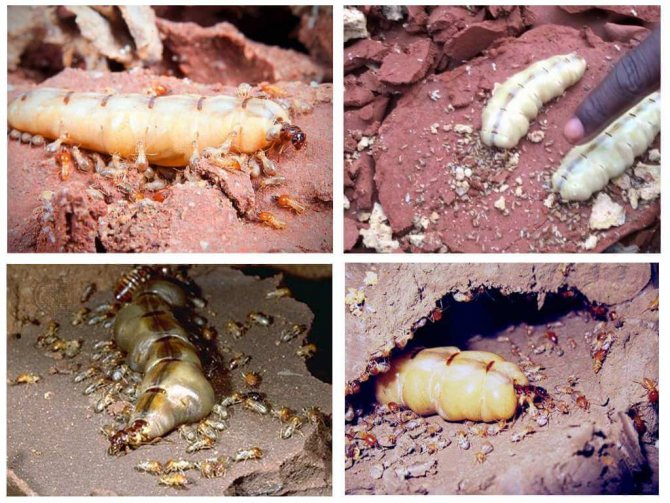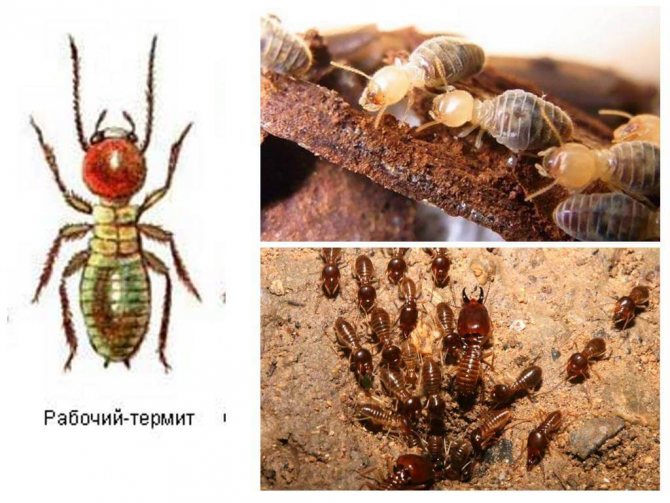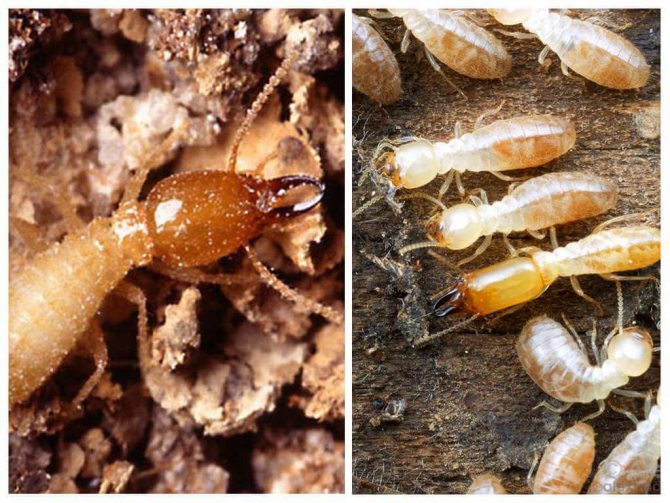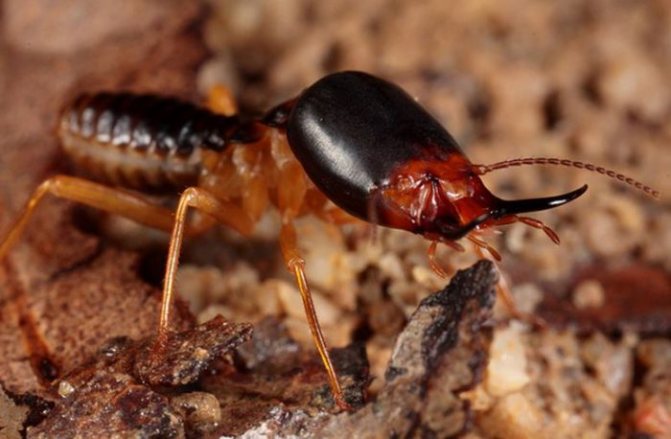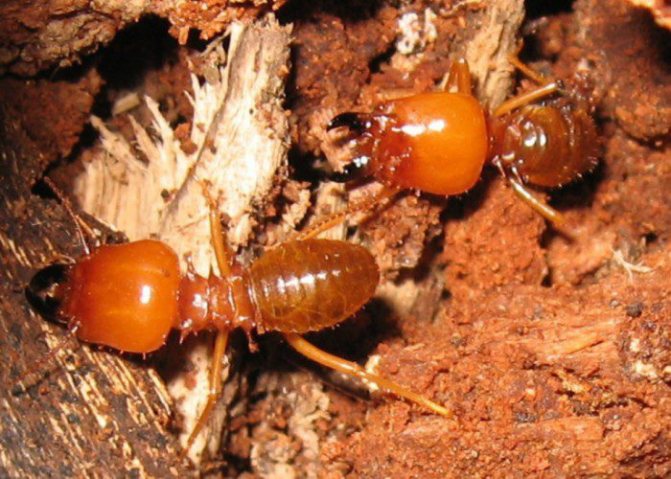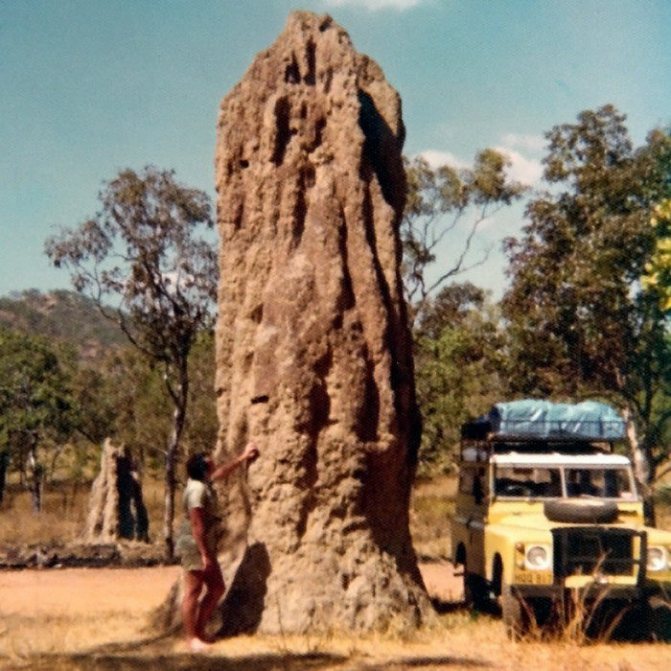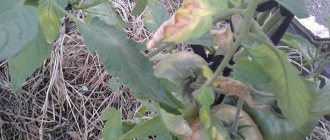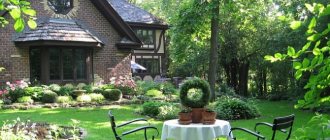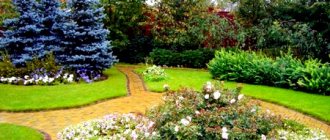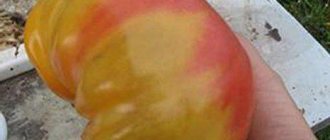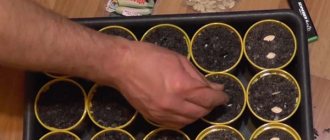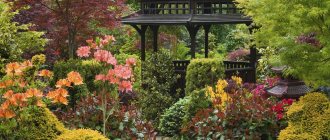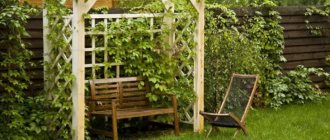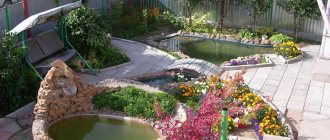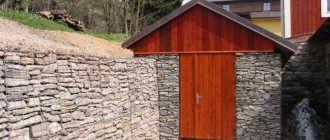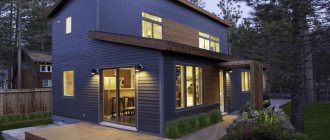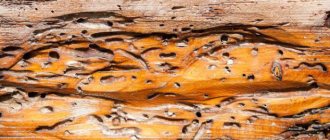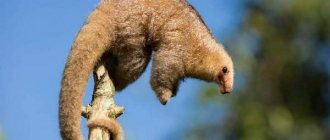REPRODUCTION
Winged individuals appear only in very large termite mounds. These are sexually mature females and males, which, in favorable weather, leave the nest in order to establish new colonies. Their wings are rather weak, and insects quickly fall to the ground, therefore they never fly a long distance. Flocks of termites that fly are a food source for many birds, small predators and lizards, so only a few of them survive.
A new pair of termites digs a nesting chamber in the ground and settles in it. This is how a new colony of termites is born. When the chamber is built, the male and female mate, and the first workers hatch from the testicles. Small larvae are fed by their parents, and when there are more of them and they grow up, the care of food production falls on the workers. From this point on, the uterus and the male are engaged only in reproduction. Young termites, having turned into workers, take up the construction of a termite mound. In addition, it is they who feed the father and mother.
In the new colony, only worker termites develop from eggs, then workers and soldiers, and only in very large termite mounds - winged individuals.
LIFESTYLE
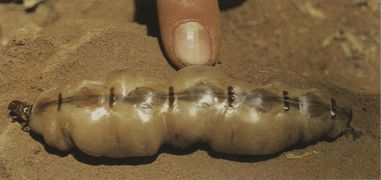
2,000 species of termites live mainly in the tropics and subtropics. Termites are "social" insects. They form large colonies in which each individual performs its assigned function. Usually in each colony, numbering from several hundred to hundreds of thousands and even millions of individuals, there is one uterus and a male that fertilizes it.
The termite mound is guarded by soldier termites, some of which have a gland channel in the process of the head, through which a sticky substance is sprayed onto the enemy. The most numerous caste are workers. They are engaged in the construction, repair, cleaning of the termite mound, take care of the eggs and larvae, get food and feed everyone: the uterus and the male, the soldiers, the larvae.
Termite mounds can be conical so that water can flow freely along their walls, or with an overhanging roof - mushroom-shaped. The walls of some termite mounds are so hard that they are difficult to break - they are built of strongly cemented clay. Some termites build nests in tree crowns, while others dig a complex network of underground corridors with a system of chambers. In all cases, there must be a certain microclimate inside.
WHAT ARE EATED
Termites eat plant foods. Only workers feed on their own. The soldiers cannot eat themselves due to their oversized mandibles. The uterus and the male are fed by the secretions of the salivary glands of workers or larvae. The smallest larvae are also fed by workers.
Usually termites feed on rotten wood, leaves, manure. This food is not fully digested, so worker excrement is eaten by other worker or soldier termites. Thus, the same food passes through a series of intestines until it is fully digested. Some species of omnivorous termites breed “mushroom gardens” in their nests, where mushrooms grow on excrement and pieces of wood. Many termites feed on wood, sometimes even consuming dry wood or pure fiber.
Power features
The basis of the diet of many types of termites is cellulose. The digestive system of working insects is inhabited by a special type of flagellar microorganisms-symbionts, capable of destroying cellulose. It is the worker termites that feed the soldier and the queen.Basically, termites feed on dead branches and tree stumps, fallen leaves, humus. Some species of tropical termites feed on living plants, damaging tea bushes and cereals. But in one of the most progressive species, Termitidae, symbionts are absent and the mechanism of cellulose assimilation in them is still unclear.
But it turned out that termites eat not only cellulose. They grow mushroom gardens where they grow a special kind of mushroom. They drag pieces of wood and leaves into their nests. All are thoroughly crushed and "planted" the spores of the mushrooms. This group of termites is referred to as the Macrotermitinae.
Fungal mycelium breaks down inedible lignin, transforming it into a more easily digestible component. Termites eat old parts of gardens, consuming mycelium, spores and nutrient-rich foods. For larvae, gardens are the main food supplier.
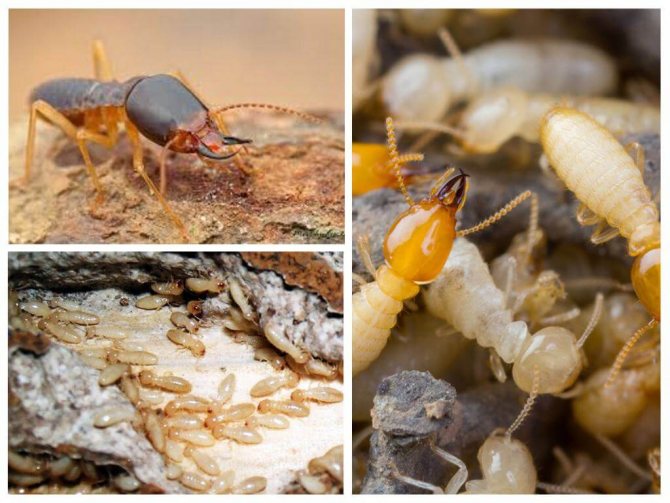

Termites
Interesting!
The famous A. Brem told his comrades how an Arab who had fallen asleep near a termite mound woke up completely naked - the termites ate all his clothes. At the end of the 18th century, termites were accidentally brought to St. Helena and completely devoured the city of Gemstown.
Termites found in the CIS are less "voracious". But the huge damage caused by the Ashgabat earthquake is due to the fact that 25% of houses were damaged by termites, which led to their collapse.
Due to the fact that termites are very sensitive to temperature, humidity and sunlight, they rarely appear on the surface, gnawing tree trunks, logs of the house from the inside, leaving it completely intact outside. The annual damage from termites is enormous. Different types of termites build different nests not only in shape, but also in localization.
ENEMIES
Soldiers are a special caste of specialized workers. They have a highly developed head capsule and powerful long mandibles. The soldiers' mandibles are so huge that they cannot chew food themselves, so the workers feed them. Many other invertebrates try to get into the termite mound. These intruders are awaited by soldiers, whose function is to detain and, if possible, destroy the enemy. In some "nosed" soldiers, a gland channel passes through the process of the head, through which a sticky liquid is sprayed onto the enemy. However, soldiers often fail to apprehend the intruder and the robber ants can completely devastate the termite mound. Anteaters and pangolins break through the wall of the termite mound and eat these insects, which form the basis of their diet.
Morphology
As a rule, they differ from other working individuals in larger sizes and more developed innate means of destruction, functionally designed to inflict damage on the enemy (in relation to ants and other insects - larger and more powerful jaws). These differences can be both absolute and proportional (greatly enlarged mandibles and hypertrophied heads, for example, in ants of the genus Pheidole
and
Pheidologeton
). In families of ants such as
Pheidole
along with the major soldiers, even larger (up to 10x relative to the minor in length and up to 500x in weight) super-major soldiers appear.
Soldiers of some termite family Termitidae
(in the subfamily
Nasutitermitinae
) have heads with a long projection ("nose") for chemical spraying of substances that scare off enemies (ants and other predators).
External polymorphism may be due to intraspecific genetic differences. On the other hand, polymorphism is possible, in which organisms with an almost identical genome, depending on external conditions, acquire different phenotypic forms.
GENERAL PROVISIONS
They live in darkness and dampness, the blind, communicate with the help of smell and taste, eat wood, can eat a wooden house, furniture, books.
Termites, or white ants, live in all tropical countries. The most famous are the giant cone buildings of African termites.They reach a height of 8-9 meters and are built from soil particles. Form "states". Workers and soldiers of termites are wingless, and future kings and queens have wings only during the period of settlement. These insects are secretive. Their underground passages are located at a depth of 4-5 meters. The larvae are fed with mushrooms, which are specially bred in termite mounds. Size - about 1 cm, an adult queen is as long as a palm.
Behavioral differences
Both interact with the tree, but in different ways. For example, termites eat the wood they nest in. Carpenter ants simply gnaw wood for the colony. They don't eat it, they just push it out through the openings of the galleries. Therefore, if you see small piles of wood shavings (insect waste) under the holes, these are ants or grinders.
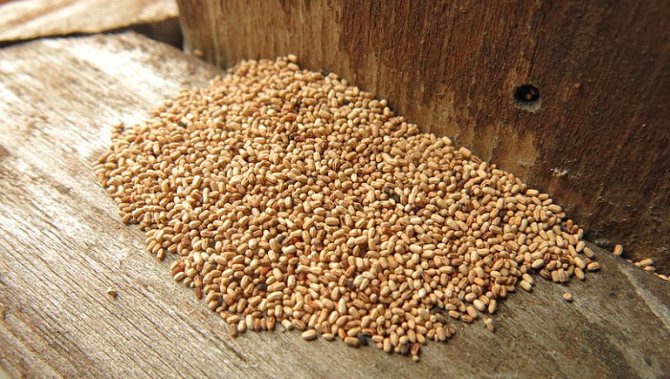

The ants look for damp, damaged wood to dig their nest. Termites eat a healthy tree.
Another obvious difference is what wooden tunnels look like. Tunnels, carpenters' galleries are smooth. Termites galleries are rough, uneven, because they are filled with layers of soil, dirt.
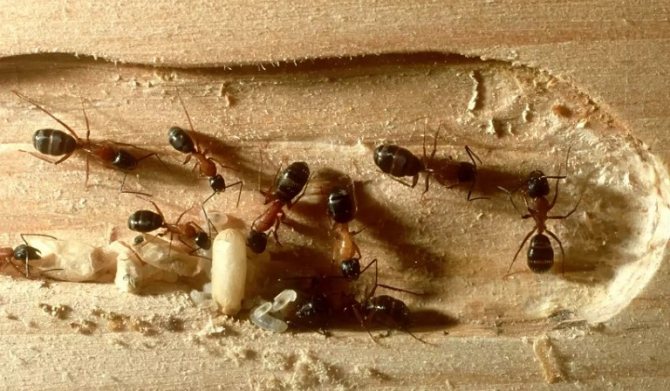

A pipe of mud indicates the presence of termites. Built outside the walls, between the ground and the tree, they serve as passageways.
INTERESTING FACTS. DID YOU KNOW THAT ..
- In hot and dry areas, the air in termite mounds is always humid. The walls of termite mounds do not allow water to pass through and do not allow moisture to evaporate, which gets inside through the mines located underground.
- In Mexico, termites have a symbiotic relationship with the ant tree: by consuming wood, they loosen the soil, giving the plant oxygen.
- Australian termites build amazing slab-like structures that look like tombstones. These termite mounds are always oriented so as not to overheat under the scorching sun.
- Termites often reach enormous sizes. For example, in India, in destroyed termite mounds, sometimes large animals hide from the weather: not only buffaloes, but even elephants.
Classification
Traditionally, 7 families of termites have been distinguished. Then added Stolotermitidae
,
Stylotermitidae
and
Archeorhinotermitidae
(Engel & Krishna, 2004). In 2009, two more families were distinguished:
Cratomastotermitidae
and
Archotermopsidae
(Engel, Grimaldi & Krishna, 2009).
- Mastotermitidae
- Hodotermitidae
- Kalotermitidae
- Termopsidae
- Rhinotermitidae
- Serritermitidae
- Termitidae
| Precambrian | Phanerozoic | Aeon | ||||||||||
| Paleozoic | Mesozoic | Cenozoic | Era | |||||||||
| Cambrian | Ordo wick | Ur force | Devonian | Carbon | Permian | Triassic | Yura | a piece of chalk | Paleo gene | Neo gene | P-d | |
| 4570 | 542 | 488,3 | 443,7 | 416 | 359,2 | 299 | 251 | 199,6 | 145,5 | 65,5 | 23,03 | million years ← |
| 2,588 |
termites ▲ ▲ ▲ ▲ ▲ ▲
TERMITNIC
Termites are often called "white ants". They got this name because they, like ants, lead a "social" way of life. But in general, they are relatives of ants, and cockroaches. The main role in maintaining life in them, like in ants, is played by sexually underdeveloped individuals.
Ventilation shafts:
the system of mines allows oxygen and heat to be well distributed.
"Mushroom Gardens":
fungi decompose cellulose.
Uterine chamber:
here the fertilized uterus constantly lays testicles.
Surface:
solid as concrete.
- Termite habitat
WHERE DIVES
Mainly in tropical and subtropical regions, up to 45-50 parallel south and north of the equator.
PROTECTION AND CONSERVATION
Termites are one of the most numerous orders of insects. Only a few species that build nests in trees are in danger due to the clearing of the jungle.
Spread
Termites are found on all continents except Antarctica. They are least represented in Europe (10 species of two genera Kalotermes and Reticulitermes) and in North America (50 species), while in South America there are more than 400 species [9], and in Africa about 1000 species. In the Kruger National Park (South Africa) alone, about 1.1 million active termite mounds were found [10].
In Asia, there are 435 species of termites, mainly in China, south of the Yangtze River [9]. There are more than 360 species of termites in Australia [9]. Because of their thin cuticle, termites are poorly represented in cold and temperate climates [11] [9]. One invasive American species (Cryptotermes brevis) was introduced to Australia [12].
Endemism
Termites. The most mysterious creatures on the Planet !!! Video (00:51:25)
TERMITES, order of herbivorous insects. killer termites Although termites used to be called white ants, they are very far from real ants. These are the most primitive of social insects.killer termites Their highly developed social organization is based on the different functions of the three main castes - producers, soldiers and workers. Most termites are found in the tropics, although they are also found in temperate regions. killer termites Their main food is cellulose, which is found in wood, grass and tree leaves, so termites can cause economic damage by damaging wooden structures and woody species. The damage caused by them is significant in tropical and warm temperate regions, although it is also observed in the south of Canada, in central France, Korea and Japan. killer termites
Human interaction
Due to their food addictions, termites in some regions have become a real scourge for wooden buildings. Their stealth and wood-eating tactics, in which its surface looks completely intact, are the reason for their late discovery. The concern is also caused by the accidental hit of termites in apartments, thanks to which their range is moving to those regions where they cannot live openly because of the climate. Once inside the house, termites are not limited to wood: anything with a high proportion of cellulose serves as potential food. The consequences of this are sometimes disastrous (for example, in South America, due to the constant presence of termites in cities, it is rare to find a book older than 50 years).
Termites try not to come into contact with air, as their cuticles are very thin and do not retain moisture. If they need to cross an open space, they build refuge tunnels from compressed earth and excrement.
Basic precautions against termite penetration:
- Eliminate wood-to-ground contact, use a concrete foundation or steel base. Even so, the termites are able to reach the tree through the tunnels; in addition, there are cases when they used water pipes for this purpose.
- Wood processing
- Using wood that is resistant to certain types of termites
If the termites have already entered the building, they are removed with insecticides. Another common method is the spraying of arsenic trioxide, a slow-acting poison used in Australia since the 1930s. The poison will be distributed among the individuals of the colony before changes are visible, which favors the destruction of the entire colony.

